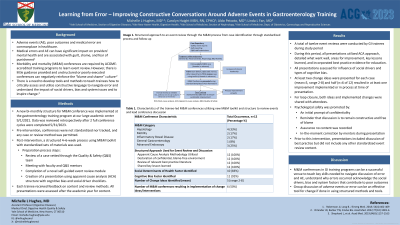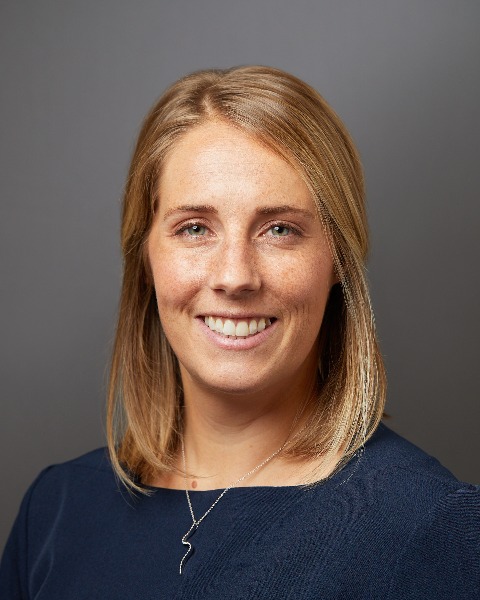Sunday Poster Session
Category: General Endoscopy
P0557 - Learning From Error – Improving Constructive Conversations Around Adverse Events in Gastroenterology Training
Sunday, October 22, 2023
3:30 PM - 7:00 PM PT
Location: Exhibit Hall

Has Audio

Michelle L. Hughes, MD
Yale School of Medicine
New Haven, CT
Presenting Author(s)
Michelle L. Hughes, MD1, Carolyn Haight, MSN, RN, CPHQ2, Aldo Peixoto, MD1, Linda Fan, MD3
1Yale School of Medicine, New Haven, CT; 2Yale New Haven Hospital, New Haven, CT; 3Yale School of Medicine, Guilford, CT
Introduction: Adverse events and medical error are commonplace. While morbidity and mortality (M&M) conferences are required by ACGME-accredited training programs, there is little guidance provided, which often leaves trainees feeling there are missed opportunities for discussion. As M&Ms move away from a culture of “blame and shame,” there is a need to develop tools and methods to teach trainees how to critically assess and utilize constructive language to evaluate the impact of social drivers, bias and system issues on poor patient outcomes and adverse events and to inspire change.
Methods: A new bi-monthly structure for M&M conference was implemented at the gastroenterology training program at our large academic center 9/1/2021. Prior to intervention, conferences were not standardized nor tracked, and any case or review method was permitted. Post-intervention, trainees followed a structured 4–6-week process using an M&M toolkit with standardized sets of materials. Preparation process included review of a case vetted through the Quality and Safety (Q&S) team, meeting with faculty and Q&S mentors, completion of a novel self-guided event review module and creation of a presentation using apparent cause analysis (ACA). Cognitive bias and social driver checklists were also completed. Each trainee received feedback on content and review methods. All presentations were assessed after the academic year for content.
Results: A total of twelve event reviews were conducted by GI trainees from 9/1/2021-5/31/2023. During this period, all presentations included an initial prompt of confidentiality to promote psychological safety, utilized ACA approach, detailed what went well, areas for improvement, key lessons learned, and incorporated best practice evidence for education. All also assessed for influence of social drivers and types of bias. At least two change ideas were presented for each case (mean=5, range 2-8) and half (n=6/12) resulted in at least one improvement implemented or in process at time of presentation. For loop closure, both ideas and implemented changes were shared with attendees. Prior to intervention, presentations included discussion of best practice but did not include any other standardized event review content.
Discussion: M&M conferences in GI training programs can be a successful venue to teach key skills needed to evaluate adverse events and the social drivers, bias and system factors that contribute to poor outcomes and can also be an effective tool for change.
Disclosures:
Michelle L. Hughes, MD1, Carolyn Haight, MSN, RN, CPHQ2, Aldo Peixoto, MD1, Linda Fan, MD3. P0557 - Learning From Error – Improving Constructive Conversations Around Adverse Events in Gastroenterology Training, ACG 2023 Annual Scientific Meeting Abstracts. Vancouver, BC, Canada: American College of Gastroenterology.
1Yale School of Medicine, New Haven, CT; 2Yale New Haven Hospital, New Haven, CT; 3Yale School of Medicine, Guilford, CT
Introduction: Adverse events and medical error are commonplace. While morbidity and mortality (M&M) conferences are required by ACGME-accredited training programs, there is little guidance provided, which often leaves trainees feeling there are missed opportunities for discussion. As M&Ms move away from a culture of “blame and shame,” there is a need to develop tools and methods to teach trainees how to critically assess and utilize constructive language to evaluate the impact of social drivers, bias and system issues on poor patient outcomes and adverse events and to inspire change.
Methods: A new bi-monthly structure for M&M conference was implemented at the gastroenterology training program at our large academic center 9/1/2021. Prior to intervention, conferences were not standardized nor tracked, and any case or review method was permitted. Post-intervention, trainees followed a structured 4–6-week process using an M&M toolkit with standardized sets of materials. Preparation process included review of a case vetted through the Quality and Safety (Q&S) team, meeting with faculty and Q&S mentors, completion of a novel self-guided event review module and creation of a presentation using apparent cause analysis (ACA). Cognitive bias and social driver checklists were also completed. Each trainee received feedback on content and review methods. All presentations were assessed after the academic year for content.
Results: A total of twelve event reviews were conducted by GI trainees from 9/1/2021-5/31/2023. During this period, all presentations included an initial prompt of confidentiality to promote psychological safety, utilized ACA approach, detailed what went well, areas for improvement, key lessons learned, and incorporated best practice evidence for education. All also assessed for influence of social drivers and types of bias. At least two change ideas were presented for each case (mean=5, range 2-8) and half (n=6/12) resulted in at least one improvement implemented or in process at time of presentation. For loop closure, both ideas and implemented changes were shared with attendees. Prior to intervention, presentations included discussion of best practice but did not include any other standardized event review content.
Discussion: M&M conferences in GI training programs can be a successful venue to teach key skills needed to evaluate adverse events and the social drivers, bias and system factors that contribute to poor outcomes and can also be an effective tool for change.
Disclosures:
Michelle Hughes: MotusGI – Consultant.
Carolyn Haight indicated no relevant financial relationships.
Aldo Peixoto: Ablative Solutions – Fees - Data Safety Monitoring Board. Bayer – Grant/Research Support. BD – Consultant. Boehringer Ingelheim – Grant/Research Support. Diamedica – Consultant. KBP Biosciences – Fees - Data Safety Monitoring Board. Lundbeck – Grant/Research Support. Reata – Grant/Research Support. Regeneron – Consultant.
Linda Fan indicated no relevant financial relationships.
Michelle L. Hughes, MD1, Carolyn Haight, MSN, RN, CPHQ2, Aldo Peixoto, MD1, Linda Fan, MD3. P0557 - Learning From Error – Improving Constructive Conversations Around Adverse Events in Gastroenterology Training, ACG 2023 Annual Scientific Meeting Abstracts. Vancouver, BC, Canada: American College of Gastroenterology.
